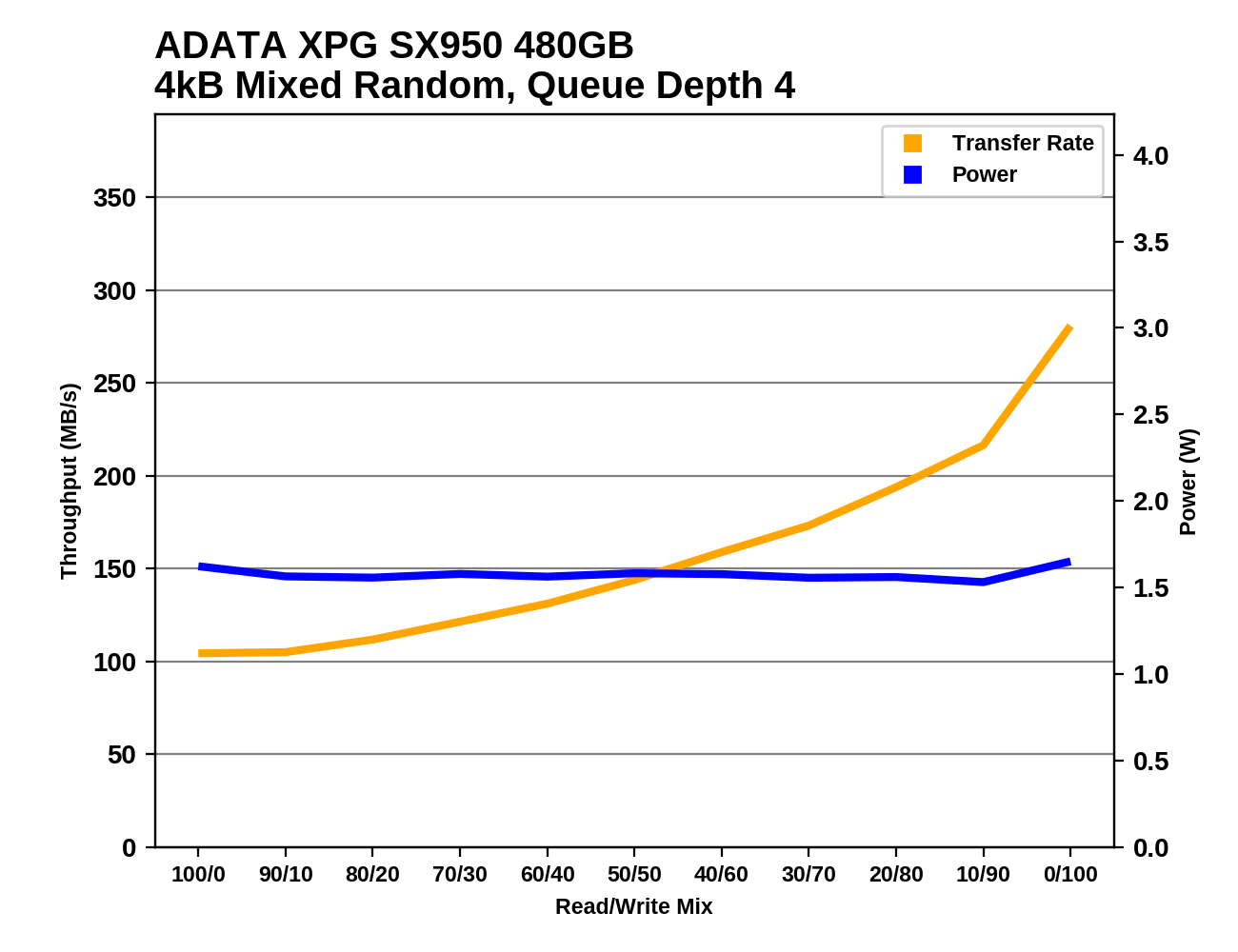The ADATA XPG SX950 480GB SSD Review: In Search of Premium
by Billy Tallis on October 9, 2017 8:00 AM ESTMixed Random Performance
Our test of mixed random reads and writes covers mixes varying from pure reads to pure writes at 10% increments. Each mix is tested for up to 1 minute or 32GB of data transferred. The test is conducted with a queue depth of 4, and is limited to a 64GB span of the drive. In between each mix, the drive is given idle time of up to one minute so that the overall duty cycle is 50%.

The overall performance of the ADATA XPG SX950 on the mixed random I/O test is just a bit average, and about 20% slower than Samsung's SATA drives.

The power efficiency of the SX950 looks a bit better, but the Samsung 850 EVO managed to tie for first place on performance wile holding a substantial lead on power efficiency. The SX950 does hold a slight efficiency advantage over the Samsung 850 PRO on this test.
 |
|||||||||
The SX950's power consumption is very flat across the varying workloads of this test, while the performance improves steadily as the share of writes grows. The top-performing Samsung drives start out about 40MB/s faster than the SX950 and most drives show a more significant performance spike when they reach the all-writes phase of the test.
Mixed Sequential Performance
Our test of mixed sequential reads and writes differs from the mixed random I/O test by performing 128kB sequential accesses rather than 4kB accesses at random locations, and the sequential test is conducted at queue depth 1. The range of mixes tested is the same, and the timing and limits on data transfers are also the same as above.

The mixed sequential I/O performance of the ADATA XPG SX950 is sub-par, though there are actually three planar MLC SSDs that are even slower. The Crucial BX300 is about 14% faster overall.

The SX950's efficiency is tied with the Crucial BX300, and both are near the top of the chart. The DRAMless OCZ VX500 is far more efficient that the rest of these drives, and without it the SX950's efficiency score would look very good.
 |
|||||||||
During the first half of this test as the proportion of writes grows, the SX950's performance increases and the power consumption drops. During the second half, the improvement falters but neither performance nor power consumption regress significantly. The Crucial BX300 is faster across the board, especially during the read-heavy parts of the test, but it requires significantly more power to deliver that higher read performance.










45 Comments
View All Comments
CheapSushi - Tuesday, October 10, 2017 - link
Next year with QLC it'll change. SATAIII is will still be useful for bulk drive SSDs coming. Yeah sure, if you're JUST a gamer and want only ONE drive for everything, it's a no-brainer on what direction to go. If you want just TWO drives, similar. But if you have more than that basic setup, SATAIII QLC SSDs are going to be perfect for bulk storage, while you have your OS and other main programs/software on an NVMe drive(s).MrSpadge - Monday, October 9, 2017 - link
Billy, you need to be less honest with your titles if you want people to actually read your review ;)RaistlinZ - Monday, October 9, 2017 - link
"In Search of Adequate"Lolimaster - Tuesday, October 10, 2017 - link
Years later and still nothing can compete with the 850 EVO 500GBmapesdhs - Wednesday, October 11, 2017 - link
This is how the exchange should go down when storage techs come up with a new SSD design and want approval to proceed:Tech: "We've designed a new SSD!"
Manager: "Is it better than the 850 EVO?"
Tech: "Umm, no."
Manager: "Go away."